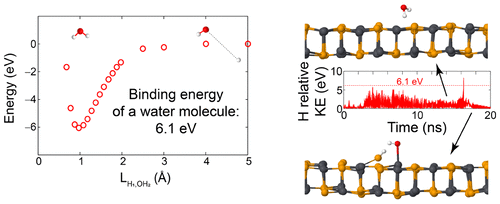当前位置:
X-MOL 学术
›
ACS Cent. Sci.
›
论文详情
Our official English website, www.x-mol.net, welcomes your feedback! (Note: you will need to create a separate account there.)
Water Splits To Degrade Two-Dimensional Group-IV Monochalcogenides in Nanoseconds
ACS Central Science ( IF 18.2 ) Pub Date : 2018-10-04 00:00:00 , DOI: 10.1021/acscentsci.8b00589 Salvador Barraza-Lopez , Thaneshwor P. Kaloni
ACS Central Science ( IF 18.2 ) Pub Date : 2018-10-04 00:00:00 , DOI: 10.1021/acscentsci.8b00589 Salvador Barraza-Lopez , Thaneshwor P. Kaloni

|
The experimental exfoliation of layered group-IV monochalcogenides—semiconductors isostructural to black phosphorus—using processes similar to those followed in the production of graphene or phosphorene has turned out unsuccessful thus far, as if the chemical degradation observed in black phosphorus was aggravated in these monochalcogenides. Here, we document a facile dissociation of water by these materials within 10 ns from room-temperature Car–Parrinello molecular dynamics calculations under standard temperature and pressure conditions. These results suggest that humidity must be fully eradicated to exfoliate monolayers successfully, for instance, by placing samples in a hydrophobic solution during mechanical exfoliation. From another materials perspective, these two-dimensional materials that create individual hydrogen ions out of water without illumination may become relevant for applications in hydrogen production and storage.
中文翻译:

水分解可在纳秒内降解二维IV型单硫族元素化物
到目前为止,使用类似于石墨烯或磷烯生产过程的类似方法,对IV型层状单硫族化物-与黑磷同质的半导体进行了实验性剥离,结果似乎仍未成功,似乎在这些单硫族化物中加剧了在黑磷中观察到的化学降解。 。在这里,我们记录了在室温下Car–Parrinello分子动力学计算(在标准温度和压力条件下)后的10 ns内,这些材料使水容易解离。这些结果表明,必须成功消除湿度,才能成功剥离单层膜,例如,在机械剥离过程中将样品置于疏水溶液中。从另一种材料的角度来看,
更新日期:2018-10-04
中文翻译:

水分解可在纳秒内降解二维IV型单硫族元素化物
到目前为止,使用类似于石墨烯或磷烯生产过程的类似方法,对IV型层状单硫族化物-与黑磷同质的半导体进行了实验性剥离,结果似乎仍未成功,似乎在这些单硫族化物中加剧了在黑磷中观察到的化学降解。 。在这里,我们记录了在室温下Car–Parrinello分子动力学计算(在标准温度和压力条件下)后的10 ns内,这些材料使水容易解离。这些结果表明,必须成功消除湿度,才能成功剥离单层膜,例如,在机械剥离过程中将样品置于疏水溶液中。从另一种材料的角度来看,



























 京公网安备 11010802027423号
京公网安备 11010802027423号